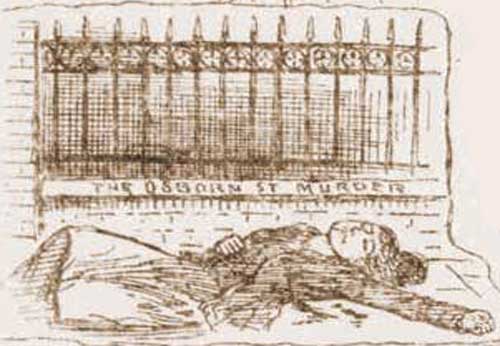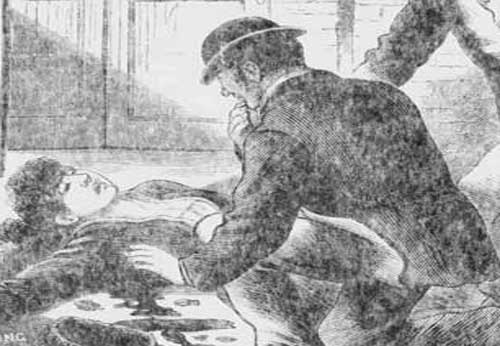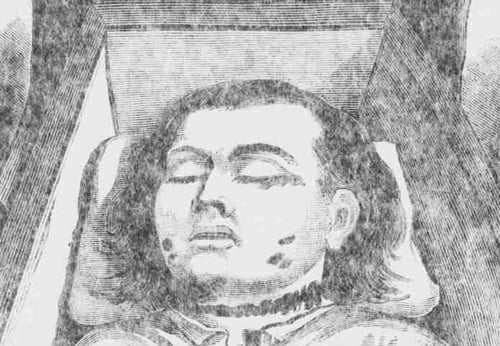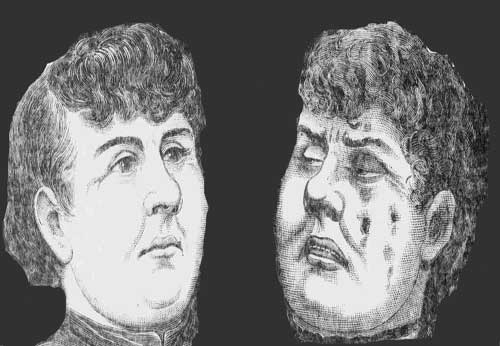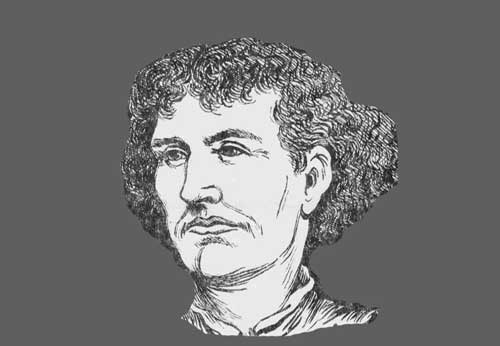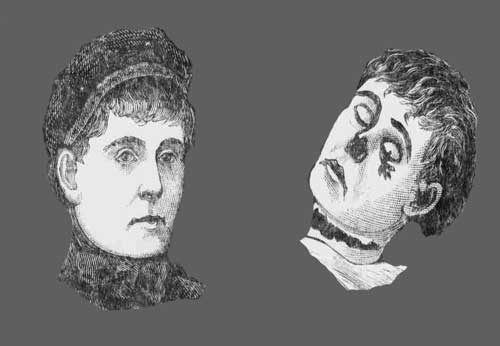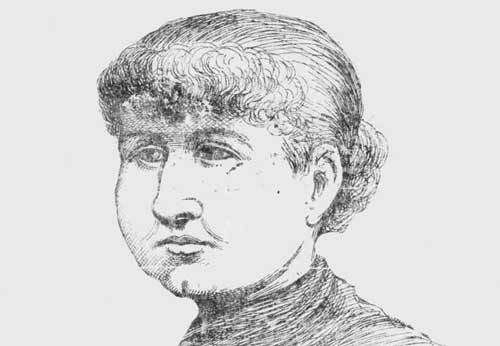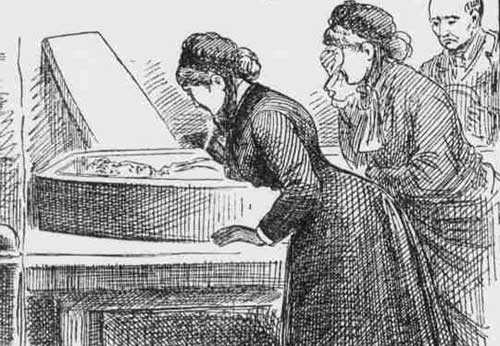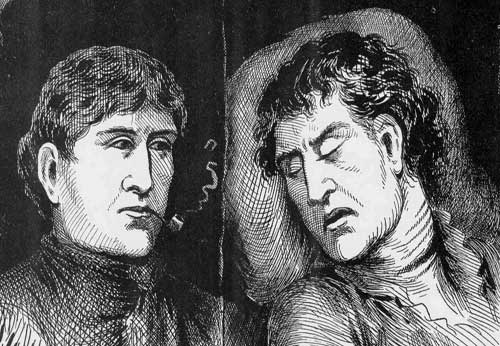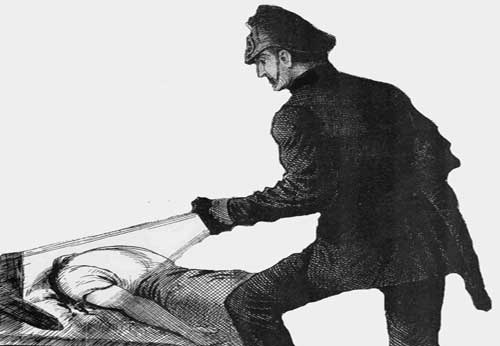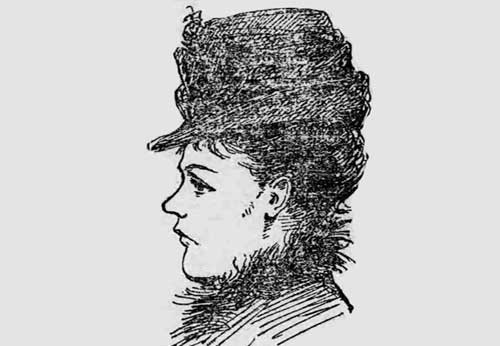- Frances Coles, murdered on Friday, 13th February, 1891, was the last Whitechapel murders victim.
- Although she is not now believed to have been a victim of Jack the Ripper, medical, police, press and public opinion at the time was divided on the issue.
- A seaman by the name of Thomas Sadler was actually arrested on suspicion of having murdered her.
- However, the case against him was unsound and he was soon released.
- Site Author and Publisher Richard Jones
- Richard Jones
FRANCES COLES - MURDERED 13TH FEBRUARY 1891
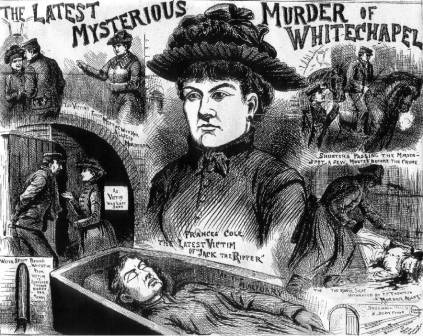
THE FINAL WHITECHAPEL MURDERS VICTIM
The final victim, whose name appears on the Whitechapel Murders file, is that of Frances Coles.
FRANCES COLES BODY DISCOVERED
Her body was discovered at 2.15 am on Friday 13th February, 1891 by Police Constable Ernest Thompson as he was passing through an archway of the Great Eastern Railway, which lead from Swallow-gardens to Orman-street.
Thompson had passed the spot 15 minutes before and was adamant that the body hadn't been there then. Returning at 2.15am he heard a man's footsteps walking away from him, and looking into the arch he noticed a figure lying on the ground.
Shining his lamp onto it he found, to his horror, that it was the body of a woman and that she was lying in a pool of blood, which was flowing from a terrible wound in the throat that ran from ear to ear.
Thompson immediately blew his whistle to raise the alarm and the neighbouring beat officers, PC Hyde and PC Hinton, came running to the scene.
They were soon joined by Police-constable Elliott who was on plain clothes duty in adjacent Royal Mint-street.
Elliot later stated that, shortly after 2 o'clock he had heard a whistle blown, and on going to Swallow-gardens saw a constable with his lamp turned on the body of a woman. he later stated that he was certain that he would have heard any cry from the woman, but everything was very quiet until he heard the whistle.
NO SIGNS OF LIFE
Checking for signs of life, the officers found the body to be quite warm and they also felt a very faint pulse.
PC Hyde was then sent to fetch the local medic, Dr Oxley, who arrived at the scene and pronounced life extinct. PC Hinton, meanwhile, headed off to the Police Station to fetch a senior officer.
He returned with Inspector Flanagan who promptly ordered the police officers who were now arriving at the scene to search the area and to stop and question anybody who they thought suspicious or who might be able to provide any information.
BODY LEFT IN POSITION
Meanwhile, in accordance with instructions issued during the murders of 1888, Flanagan ordered that the body was to remain in the position in which it was discovered, and he then carried out an in depth search of the surroundings for clues.
Soon Dr George Bagster Philips, the Divisional Police Surgeon, had arrived at the scene and, on examining the body, he found two cuts to the woman's throat, which, he stated, were "sufficient to account for death."
Crucially, Philips was of the opinion that the nature of the wound and the posture of the body did not connect this murder "...with the series of previous murders which were accompanied by mutilation..."
PRESS OPINION
However, several newspapers were quick to connect this murder with the previous Jack the Ripper murders and, on 14th February 1891, The Times reported that:-
Another murder, although not so fiendish in all its details as those which were enacted within a comparatively short period of one another in Whitechapel in 1888 and 1889, has been committed in the same district, and the many similar circumstances surrounding this latest mysterious crime seem to point to its being the work of the same person. The place, the time, the character of the victim, and other points of resemblance, recall in the most obvious way the series of crimes associated in the popular mind with the so-called "Jack the Ripper...”
The East London Advertiser, in an article in the Saturday 14th February 1891 edition, observed that the woman's injuries were not really comparable with those suffered by previous victims, but noted that there were most certainly similarities in the choice of victim, the time of the murder, and the location of the murder.
Since the woman had not been formally identified when the inquest into her death opened on Saturday 14th February the Coroner referred to her as "as a woman unknown."
However, people had come forward to identify her as Frances Coles, who, for some months past, had resided in common lodging-houses in Thrawl-street and Flower-and-Dean-street, and who had, in the words of The Times been leading an irregular life.
WOMAN IDENTIFIED AS FRANCES COLES
On the night of Saturday 14th February 1891, Detective-sergeants Record and Kuhrd managed to locate Frances Coles father, James William Cole, who was in Bermondsey Workhouse, and Mary Ann Coles, her sister, who lived in Kingsland. According to the East London Advertiser:-
The old man, who is very feeble, was taken to the mortuary in a cab, and had no difficulty in identifying the body as that of Frances Coles, his daughter. Another sister, named Selina, is also known to be living at Kingsland. The deceased was at one time engaged as a labeller at a wholesale chemist's factory in the Minories. It has transpired that she left her lodgings in Thrawl-street about five weeks ago, but on Thursday last, between 9 and 10 o'clock, returned and asked her landlady, Mrs. Hague, to let her come back, and promised to pay what she owed. She then went away, but Mrs. Hague subsequently saw her in a public-house at the corner of Montague-street. She was with a man, who was treating her to drink. He was of fair complexion, and had a light moustache. Mrs. Hague also identified the body...”
A SUSPECT SUGGESTED
Now that the woman had been identified as Frances Coles the police turned their attention to who might have been responsible for her murder and became very interested in the identity the man who Mrs Hague had seen treating her to a drink.
JAMES THOMAS SADLER
It soon transpired that her companion had been James Thomas Sadler, a fifty-three year old merchant seaman and fireman on the S.S. Fez, whom she had met in the Princess Alice Pub on February 11th, two days before her murder. Sadler was a former client of hers and, after a few drinks, they decided to spend the night together.
They spent most of February 12th 1891 on a pub crawl around the area and by evening both of them were extremely intoxicated.
At around 7.30pm that evening Frances turned up at a milliners shop at 25 Nottingham Street where she bought a black crepe hat, paying for it with 2s. 6d. that Sadler had given her some hours before. According Peter Hawkes, the man who served her, Frances was "three sheets in the wind."
Leaving the shop she had, according to Hawkes, gone off in the company of a man who had been looking in through the window whilst Coles was in the shop. Hawkes would later pick Sadler out of a line up at Leman Street Police Station as the man she had gone off with.
SADLER ATTACKED IN THRAWL STREET
Later that night, as they were making their way along Thrawl Street, Sadler was attacked by a woman in a red shawl who came upon him from behind. Two men who were with the woman then robbed him of his watch and money.
It appears that Frances watched the attack and failed to intervene, much do Sadler's disgust who told the police during questioning that he had been angry at Frances for not helping him when he was down. An argument ensued and the two of them went their separate ways.
At 11.30pm a very drunk Frances Coles turned up at the lodging house where they had spent the previous night. Sitting down on a bench in the kitchen she rested her head on her arms and promptly fell fast asleep.
A very belligerent Sadler turned up soon after, his face bloodied and bruised. "I have been robbed," he told Charles Guiver, the night watchman, "and if I knew who had done it I would do for them." Guiver helped Sadler clean up in the back yard.
FORCED TO LEAVE THE LODGING HOUSE
But since Sadler didn't have any money to pay for a bed he had no choice but to ask him to leave.
At 12.30am on 13th February Frances woke up and, since she also lacked the money for a bed, was forced to leave the lodging house.
A LAST SIGHTING OF FRANCES COLES
At 1.45 am Frances met fellow prostitute Ellen Callana on Commercial Street. Shortly after this meeting, according to Calana's later testimony, she was solicited by "a violent man in a cheesecutter hat." Calana refused him, whereupon the man punched her in the face and blacked her eye. He then approached Frances Coles who ignored Calana's advice to leave the man well alone and headed off towards Minories with the man.
A VIOLENT ALTERCATION
Meanwhile Thomas Sadler had tried to force his way back on board his ship, the SS Fez, and had become involved in a violent altercation with a group of dockworkers in the course of which he sustained a nasty scalp wound.
Having made two attempts to get into a lodging house in East Smithfield, Sadler was next spotted on the pavement outside the Royal Mint by Sergeant Edwards who later recalled that he had appeared "drunken and bloodied." The officer could plainly see that the Sadler had been assaulted, and questioned him. Sadler stated that he had been attacked by some men, against the London Dock gates, who had "brutally ill-used him."
SADLER ARRESTED
On the Saturday morning, acting on descriptions and information from various witnesses, including Sergeant Edwards, Detective-sergeant Don and Detective Gill tracked Sadler down at the Phoenix beer house and arrested him.
Saddler offered no resistance and was arrested and taken before Chief Inspector Donald Sutherland Swanson, who, having cautioned him, subjected him to a searching examination.
Sadler admitted to having known Frances Coles and to having also been in her company. However he was adamant that he had had nothing to do with her murder.
There were reports in the press that the cut on Frances Coles throat was very like the cut on Alice Mackenzie's throat and there was evidently some suspicion that he might also have been responsible for that crime, if not the other Whitechapel murders.
On 17th February 1891 The Times reported that:-
...The police, after detaining the man James Thomas Sadler upwards of 40 hours in the Leman-street Police-station, considered that they had then sufficient evidence to charge him with the wilful murder of the young woman, who has now been positively identified as Frances Coles; and the charge was formally preferred by Detective Inspector Moore about 12 o’clock on Sunday night...”
Police enquiries had also uncovered a man by the name of Donald Campbell, who claimed that he had purchased a knife from Sadler on the Friday morning for one shilling. Campbell had noticed that the knife's handle was "clammy" and that its blade was stained.
He, therefore, washed the knife, noticing as he did so that the water had a reddish appearance. Campbell afterwards sold the knife, but was able to provide detectives with the name of the person who had purchased it from him and, according to The Times:-
...By that means it was secured. On Sunday morning Campbell went to the Leman-street Police-station and picked Sadler out from amongst a number of other men..."
SADLER CHARGED WITH THE MURDER
On 24th February 1891 Sadler appeared at the Thames Police-court charged with "...willfully causing the death of Frances Coles by cutting her throat with a knife on the 13th inst..."
THE INQUEST VERDICT
On Friday 27th February 1891 the inquest into Frances Coles death drew to its conclusion.
The Coroner, Wynne Baxter, told the jury that the case "...had many characteristics in common with the murders which had preceded it; but it was for the jury to decide, taking well into consideration Sadler’s drunken condition, the conflicting evidence as to times and the connected account given by him of his movements before and after the murder was committed, whether they could fairly charge him with the deed, or must attribute it to some person or persons unknown..."
The jury retired to consider their verdict, and on their return, the foreman said: - "We find that the deceased was willfully murdered by some person or persons unknown, and we wish to say that we think the police did their duty in detaining Sadler."
For a time it seemed as though Sadler's guilt in connection with the murder of Frances Coles was proven and there was speculation that Jack the Ripper may well have been caught at last.
THE CASE AGAINST SADLER COLLAPSES
But then the case against him fell apart. Sadler was able to prove that he had, indeed, been mugged, and that he had not actually been with Frances Coles in the hours before she was murdered.
When it was also revealed that his knife was probably too blunt to have inflicted the wound on Coles's throat, the case against him collapsed. He was also able to prove that he had been at sea when some of the other murders had occurred.
In early March 1891 the Director of Public Prosecutions wrote to Sadler's solicitors informing them that:
...So far as the prosecution is concerned, it is not intended to offer evidence tomorrow before the magistrate herein, and application will be made to him to permit the adoption of this course...”
On Tuesday 3rd March 1891 Sadler again appeared before the Magistrate. The prosecution told the court that:-
Having had the advantage of a consultation with the learned Attorney-General, who has carefully considered the evidence given in the course of the inquiry before the coroner, as well as the most able summing up to the jury impanelled before him, and having regard to the verdict returned by that jury, after a patient and exhaustive inquiry, I do not propose, on the materials at present in our possession, to proceed further with this prosecution, and, Sir, if it should meet with your approval, it will have the sanction both of the learned Attorney-General and of the Treasury authorities, that no further evidence should now be offered against the accused. ”
SADLER CHEERED FROM COURT
Evidently there were many who had been convinced of Sadler's innocence and, as Sadler left the court, he was greeted by a large crowd who proceeded to cheer as a cab drove him away. The crowd ran after his carriage, whereupon, according to The Times, "Sadler put his head out of the cab window and waved his hat..."

